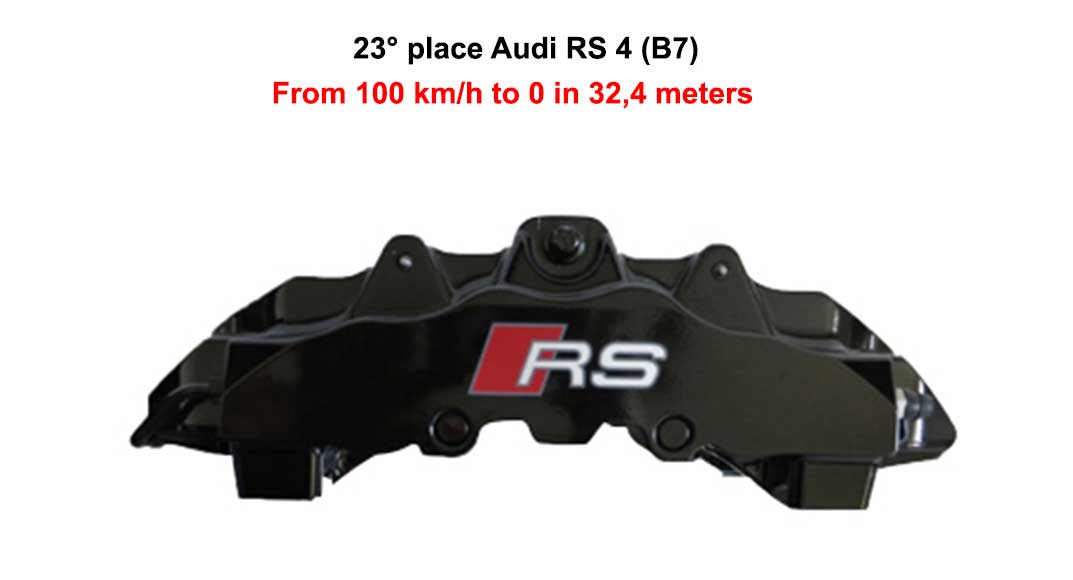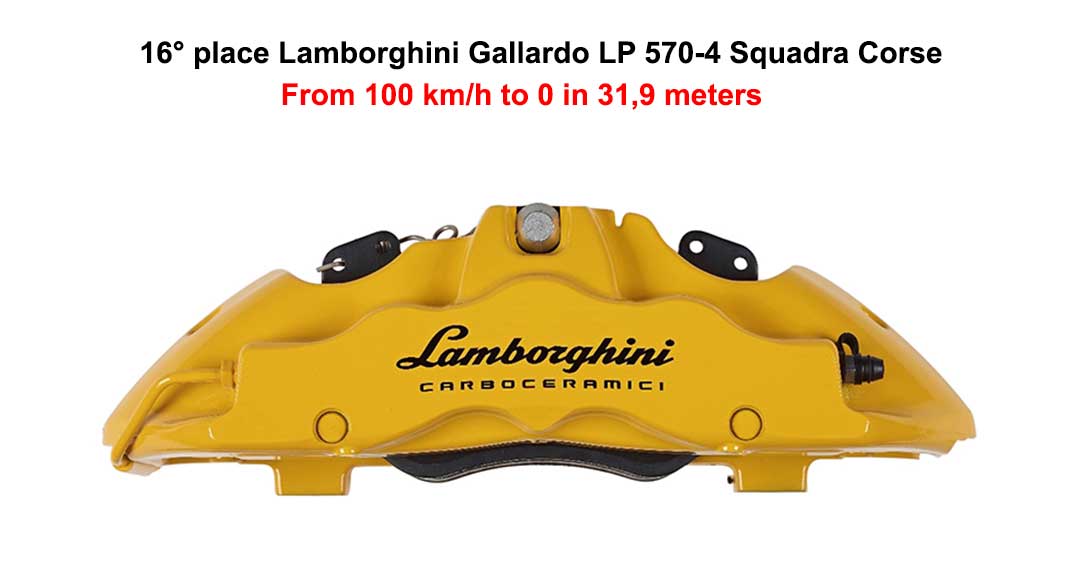
Features
Engine: V8, 4,163 cc with 420 HP at 7,800 rpm
Tires: 255/40/18 front and rear
Weight: 1,650 kg (dry)
A car's reactivity is the result of many well guessed features, including the braking system. A high breaking torque and the greatest stiffness can be achieved by using of one of Brembo's aluminum fixed calipers with 8 pistons.
Brembo's fixed calipers stand out for their light weight, performance and design which are specific of aluminum parts compared with cast iron.
They can provide the cars with the advantages connected with the weight and residual torque reduction resulting in a reduction of the polluting emissions and in fuel saving.
Features
Engine: 4 cylinders turbo 1,598 cc with 218 HP at 6,000 rpm
Tires: 205/45/17 front and rear
Weight: 1,160 kg (dry)
Small is beautiful but it can provide great satisfaction, both while accelerating as well as during braking. This is only possible with Brembo's front aluminum fixed calipers with 4 pistons that can ensure a prompt response, a remarkable breaking torque and an uncommon aesthetic refinement.
Brembo pays a special attention to the aesthetics of its calipers, the braking system's part that shows most. Also thanks to an approach that is based on co-designing with the main car manufacturers, the design is very well-finished so that it can perfectly blend in with the overall aesthetics of the most exclusive models.
In fact Brembo's calipers aren't only created with the most complex and elaborate chromatic finishes but they often stand out for a design that recalls and blends in with the car's distinctive style features.
Features
Engine: 6 cylinders TwinPowerTurbo, 2,979 cc with 460 HP at 6,000 rpm
Tires: 265/35/19 front, 285/30/20 rear
Weight: 1,580 kg (dry)
A car that makes such a great use of carbon that Brembo's carbon-ceramic discs were a must, 400 mm in the front and 380 mm at the rear. This solution allows to save 50 per cent of the weight compared to the cast iron discs, this obviously with less engine power dissipation.
The reduced unsprung weights improves the car's dynamic behavior while the braking force is assured by the fixed monobloc caliper with 6 pistons in front and 4 pistons at the rear.
Features
Engine: V8 4,308 cc with 510 HP at 8,500 rpm
Tires: 235/35/19 front, 285/35/19 rear
Weight: 1,458 kg (dry)
Compared with Brembo's braking system for the F430, the front discs' diameter (up to 398 mm) has been increased to improve the braking efficiency.
The discs (350 mm diameter for the rear one) are made from a carbon-ceramic material that ensures an unparalleled performance and a remarkable aesthetic impact.
Thanks to Brembo's calipers the braking performance is excellent and constant also on the track. 6 piston calipers in the front and 4 piston ones at the rear, assisted by pads that allow a suitable thermal discharge.
Features
Engine: V6, 3,597 cc with 300 HP at 6,600 rpm
Tires: 235/35/19 front, 305/30/19 rear
Weight: 1,205 kg (dry)
Also the sports coupé that are produced in limited numbers can't do without Brembo's components if they want to excel in light weight and braking performance.
The breathtaking Artega GT in the front uses fixed calipers with 4 pistons that act on Brembo's 316 mm diameter two-piece discs. The radial-mounted fixed calipers and the composit discs give the brakes a greater breaking torque and thermal capacity.
The result is a more immediate and decisive braking that can be noticed even during normal road usage but that is also incredibly powerful and consistent under the repeated loads during track use.
18th place Volkswagen Golf GTI Clubsport S –
From 100 km/h to 0 in 32.1 meters
Features
Engine: 4 cylinders in-line 1,984 cc with 310 HP at 5,800 rpm
Tires: 235/35/19 front and rear
Weight: 1,388 kg (dry)
NOTE This car is in the ranking also with the Golf Clubsport, that requires 32.4 meters to stop.
-en.jpg)
Features
Engine: 6 cylinders, 3,800 cc with 408 HP at 7,300 rpm
Tires: 235/35/19 front, 305/30/19 rear
Weight: 1,539 kg (dry)
Could a special limited edition series like this use a second class braking system? Never ever.
To experience the perfect braking it uses 350 mm discs manufactured by Brembo SGL Carbon Ceramic Brakes on both axles. They work together with aluminum monobloc fixed calipers (6 pistons in the front and 4 at the rear) that provide light weight, reduced residual torque and the best braking pressure even when the stress is extreme.
Brembo pays a special attention when designing brake calipers that have to combine performance requirements with comfort. Behind Brembo and its system approach there is an in depth knowledge for all the elements involved in the braking action. Therefore it can ensure the highest comfort when these products are used.
NOTE This car is in the ranking also with the 911 GT3 that requires 32,9 meters to stop and with the 911 GT2 RS and the 911 Carrera S that both require 32,2 meters

Features
Engine: V10, 5,204 cc with 570 HP at 8,000 rpm
Tires: 255/35/19 front, 335/30/20 rear
Weight: 1,340 kg (dry)
Right from the name that is focused on the racing department, one can gather the will to aim at staggering performances. Therefore Brembo's (400 mm and 380 mm) carbon-ceramic discs are a must. They weigh half the weight of the traditional discs with a friction coefficient that is 25 per cent higher.
They require 20 days and 16 production phases to be produced but the final result makes the waiting really worthwhile. The calipers complete the braking system with 6 pistons in the front and 4 at the rear.
Brembo's fixed calipers improve the system's durability and efficiency: in fact the use of several opposed pistons allows a more precise action on the pads. This is due to a reduced piston diameter, to less pressure exerted on each individual piston and to a more uniform friction surface owing to a greater surface for the pad's action.
NOTE This car is in the ranking also with the Gallardo LP 560 – 4 Spyder that needs 32.7 meters to stop and with the Gallardo LP 570-4 Superleggera that only needs 32.2 meters.
Features
Engine: V10, 8,382 cc with 654 HP at 6,200 rpm
Tires: 295/30/18 front, 355/30/19 rear
Weight: 1,642 kg (dry)
If you haven't yet done so, check out the engine's capacity. Now that you have closed your jaw just think at what all that can mean for a braking system.
Power is needed for the most extreme braking but also resistance and heat dissipation capacity. In order to satisfy these requirements, Dodge's engineers have chosen Brembo's calipers with 4 pistons in front and 2 pistons at the rear that are optimized to reduce the overall weight.
Features
Engine: V12, 6,498 cc with 700 HP at 8,250 rpm
Tires: 255/35/19 front, 335/30/20 rear
Weight: 1,701 kg (dry)
The very moment this Lamborghini was unveiled to the public it was as if it arrived directly from the future, this because of its sharp lines. Its braking system, that has been studied by Brembo in co-design with the carmaker, instead is extremely up to date and it blends in with the car's overall aesthetics.
The carbon-ceramic discs have a 400 mm diameter in the front and 380 mm diameter at the rear and together with the monobloc calipers ( 6 and 4 pistons) allow breathtaking hard brakings.
Brembo has been the first company to produce aluminum monobloc calipers. The first specimens were fitted on the Ferrari 126 C2 that took part in the Formula 1 World Championship in 1982.
NOTE This car is in the ranking also with the Aventador LP 750-4 Superveloce that needs 32.6 meters to stop.
Features
Engine: V10, 5,204 cc with 640 HP at 8,000 rpm
Tires: 245/30/20 front, 305/30/20 rear
Weight: 1,382 kg (dry)
It's been designed to be the fastest Huracán of all times and has been redesigned using ultra-light materials that have reduced its weight by about 40 kg.
Brembo's monobloc fixed calipers with 6 pistons in the front and 4 pistons at the rear have been picked to keep the engine's exuberance at bay : both have been co-designed to perfectly blend in with the car's overall aesthetics and with the carbon-ceramic discs that have a 380 mm diameter and 38 mm thickness in the front and 356 mm diameter and 32 mm thickness at the rear.
Brembo's carbon-ceramic discs aren't only powerful but they also make the car lighter and easier to handle and they provide a constant braking force even after repeated operation.
NOTE This car is in the ranking also with the Huracán LP 610 that needs 32.9 meters to stop
12th place McLaren 675 LT –
From 100 km/h to 0 in 31.8 meters
Features
Engine: V8, 3,799 cc with 675 HP at 7,100 rpm
Tires: 235/35/19 front, 305/30/20 rear
Weight: 1,434 kg (dry)
Features
Engine: V12, 7,291 cc with 602 HP at 6,150 rpm
Tires: 255/35/19 front, 335/30/20 rear
Weight: 1,328 kg (dry)
Could have a Pagani been missing in the ranking? Of course not.
Despite its name that is taken from a hot wind blowing in the Argentinian pampas, the cooling of the brakes is always under control thanks to the 380 mm carbon-ceramic discs and to the monobloc calipers (6 and 4 pistons) that are all being produced by Brembo.
